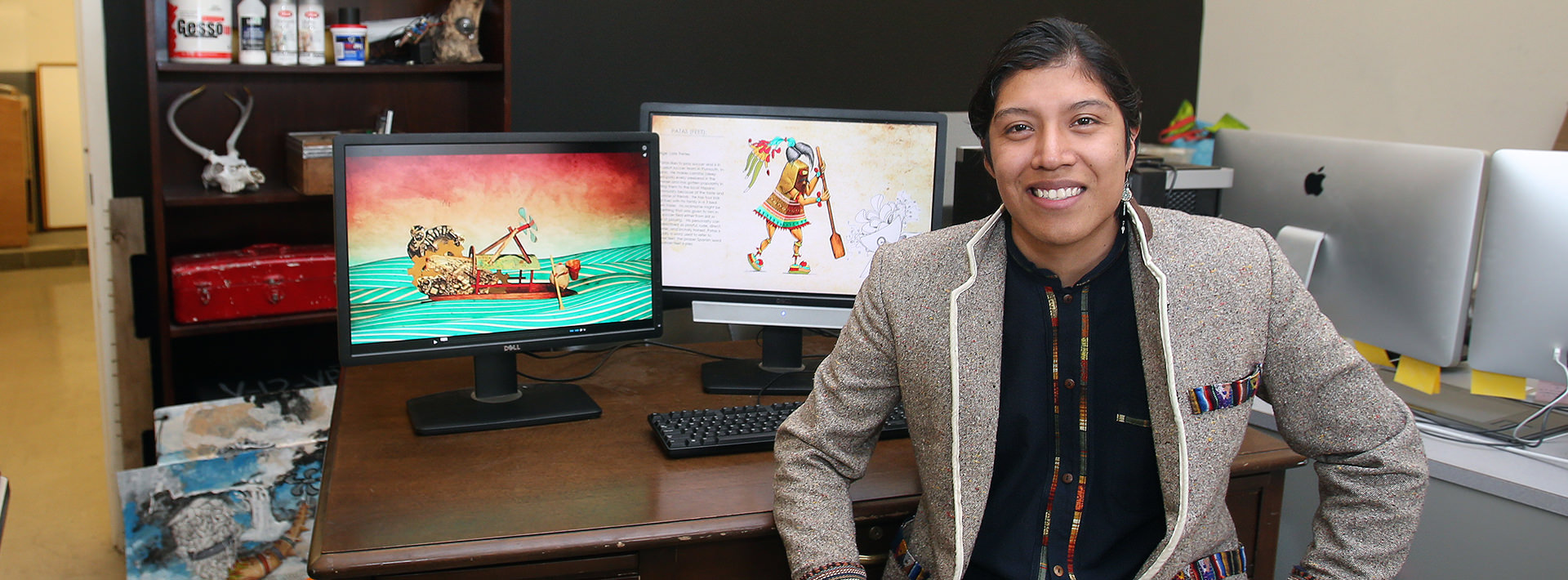Class of 2015 Success Stories: Using Art to Bridge Cultures
‘Cultural Shock’ Propels Graduate to Use Talent to Facilitate Understanding

By Liz Gladieux
When Federico “Rico” Cuatlacuatl left his home in a tiny Mexican town at age seven, he had no idea what lay ahead of him. He had not even seen his father for over a year. “My father left one year for America. My mother left to join him later and finally my brother and I came,” said Cuatlacuatl. “When we landed and saw New York, it was complete cultural shock!”
That cultural shock has stuck with Cuatlacuatl and shaped his life and his future. The Puebla, Mexico, native graduated from Bowling Green State University with a Master of Fine Arts degree in animation and a community legacy of bridging cultures and empowering people through art.
Cuatlacuatl’s parents left Mexico in search of a better life for their sons—his father found work in the factories of Plymouth, Ind., and his mother worked there also before starting to clean houses in the town. There was a strong work ethic and humbleness in the family. His father worked long hours to provide financially for the family and his mother encouraged her sons to study and follow their dreams.
Cuatlacuatl and his brother spoke no English and found making friends and communicating difficult. “I began to draw at a young age,” said Cuatlacuatl. “It helped me connect with people and bridge the communication gap. It also helped me escape from and embrace the cultural shock I felt.”
Soon, friends and teachers were noticing his artwork and it won awards in school competitions. He started entering larger competitions. “I just kept growing,” he said. “I won some national awards and scholarships. In Colorado, I was among the top 60 young artists in the nation.”
“My understanding grew of how art is a powerful means to engage people. It empowers in many social, political and personal ways”Cuatlacuatl’s parents’ dreams for their sons included higher education and embracing their dreams. “No one in my family had ever gone to college. In fact, my mother got her GED and fulfilled her own dreams,” Cuatlacuatl noted. He wanted to go to college and get a degree in art, but another roadblock surfaced. “I was an undocumented immigrant and many colleges didn’t want to take a chance and admit me,” he said.
Ball State University gave him the opportunity to be a first-generation college graduate when he received his BFA in animation. Why did he choose animation? “I wanted to ensure that I had a degree that would enable me to get a job. Animation is still in art and it is a growing field,” said Cuatlacuatl, now a fully documented resident. His drive led him to enroll in BGSU’s Master of Fine Arts program.
“My understanding grew of how art is a powerful means to engage people. It empowers in many social, political and personal ways,” said Cuatlacuatl. His efforts in the Bowling Green community have included La Connection, Art Walk and teaching computer literacy at the Wood County Public Library.
His drive to connect people and cultures through art led him to Toledo’s Sofia Quintero Center as well as the Bowling Green community. “We need to bring art out of the studio and combine community work and studio work,” said Cuatlacuatl. “We recreated a Mexican carnival here complete with costumes, art and celebration.” Cuatlacuatl has big plans for the carnival to grow and to bridge communities.
Dr. Katerina Ruedi Ray, director of BGSU’s School of Art has high praise for Cuatlacuatl. “His leadership, in collaboration with the Sofia Quintero Arts and Cultural Center, to bring the Carnival of Huejotzingo from Indiana to Toledo as part of his final MFA project, broke new ground in our graduate program, engaging a vital regional community in the work of a talented digital arts graduate student.
“Rico Cuatlacuatl has a tremendous sensitivity to the intersection of tradition and innovation, and a deep commitment to make art meaningful in everyday life, particularly in the life of the Latino community,” said Ruedi Ray. “He wants to make the ‘invisible’—in his case the artistic and cultural traditions of undocumented Mexican immigrants—visible through his art.”
His plans for the future include deciding on a job in the film animation arena, so he can become financially stable. His biggest motivator is his 4-year-old son Toetl. “He is a great motivator and always wants me to draw things for him,” noted Cuatlacuatl. “I want him to find what makes him happy and I want to help him achieve it.”
Updated: 12/02/2017 12:46AM
